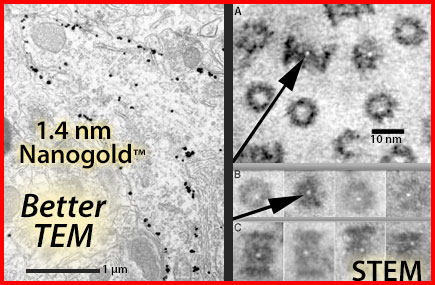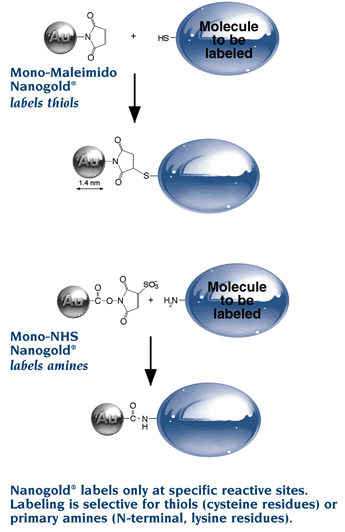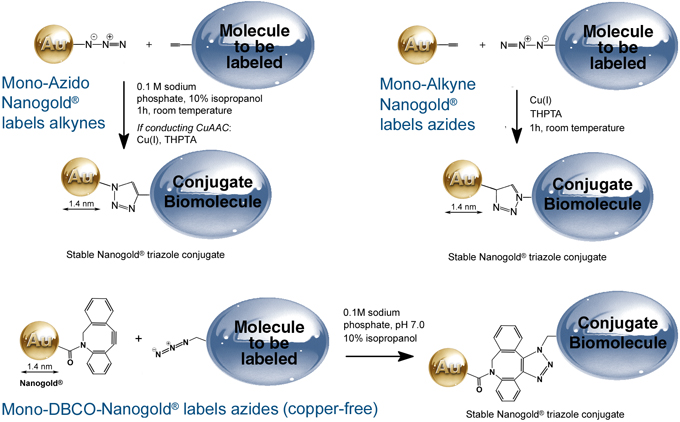|
|
 1.4 nm Nanogold® Labeling Reagents 1.4 nm Nanogold® Labeling Reagents
Updated: January 8, 2025
Nanogold® is a better gold label. The 1.4 nm Nanogold® particle is a gold compound: it is not just adsorbed to proteins, like colloidal gold, but covalently reacts at specific sites under mild buffer conditions. This gives a well defined product that can be purified chromatographically.
Nanogold® brings the versatility of fluorescent conjugation to gold labeling.
Label any molecule with a suitable reactive group: oligonucleotides, lipids, peptides, proteins, enzyme inhibitors and others. This is a big improvement over colloidal gold, which may be adsorbed only to antibodies and a limited range of proteins and peptides.
Nanogold® is small and highly uniform in size, in sharp contrast to small colloidal gold preparations (most commonly used "1 nm" colloidal golds actually range from 1 to 3 nm).
Label your own biomolecules with our Nanogold® labeling reagents,
or check out our range of antibody IgG, Fab' and streptavidin Conjugates with Nanogold®.
 |
Left: Silver-enhanced Nanogold®-labeled K+ channel Kv2.1 subunit in rat brain, X15,000 (J.-H. Tao-Cheng, NIH).
Right: Darkfield STEM micrographs of Maleimido Nanogold® labeled A β peptide targeting proteasomes; sample was stained with methylamine vanadate. White dots are 1.4 nm Nanogold®.
From Gregori, L., Hainfeld, J.F., Simon, M.N., and Goldgaber, D. (1997). Binding of amyloid beta protein to the 20S proteasome. J. Biol. Chem. 272, 58-62. |
Although 1.4 nm Nanogold® is smaller than most other EM probes, it can easily be enhanced with GoldEnhance™ or silver (LI Silver or HQ Silver) by brief exposure (1 - 5 min.) to produce highly visible grains 2-20 nm in size (depending on development time). Further development (8-25 min.) gives a black signal easily seen in the light microscope and on immunoblots, polyacrylamide gels and Western blots.
Features of Nanogold®
- Unparalleled penetration of conjugates -up to 40 µm!
- Higher density of immunolabeling
than with larger gold probes.
- Can be conjugated to any molecule with a suitable reactive group. Available with different reactivities.
- Extremely uniform 1.4 nm gold particle.
- Label at specific sites
which do not obstruct native reactivity.
- Close to stoichiometric labeling.
- Reacts under mild, neutral conditions.
- Conjugates are easily isolated by gel filtration.
- Conjugates are stable to a wide range of pH
and ionic strengths.
- High stability: conjugates show unchanged reactivity after storage for a year.
After labeling with Nanogold®,
get rapid, precise enhancement
with our Silver Enhancers
or new GoldEnhance™! |
 |
 Monomaleimido Nanogold® - Instructions Monomaleimido Nanogold® - Instructions
Prepare the smallest gold immunoprobe with your own primary antibody
for unsurpassed resolution, penetration and localization, or label a variety of other biological molecules.
Monomaleimido Nanogold® is the 1.4 nm Nanogold® compound with a single reactive maleimide that reacts with thiols (sulfhydryls) under mild conditions (pH 6.0 to 7.0).
1.4 nm Monomaleimido Nanogold® may be used to covalently label Fab', IgG, proteins or peptides containing cysteine, and other molecules with sulfhydryls -- Use our unique gold labeling reagents just as you would use fluorescent labeling reagents.
Easy to use: Simply mix reconstituted Monomaleimido Nanogold® with the target molecule for one hour at room temperature or 16 h in the refrigerator, then chromatographically purify the product by gel filtration, ion exchange chromatography or hydrophobic interaction chromatography. The maleimide on the 1.4 nm Nanogold® particle specifically reacts with a free sulfhydryl under mild conditions to produce a stable covalent bond.
A similar product based on the smaller 11 gold atom cluster, undecagold, is also available (Monomaleimido-Undecagold).
Applications:
- Create your own small gold probes by linking Nanogold® to your primary antibody Fab' fragments. [References]
- Label other proteins directly for high resolution site specific identification.
- Label peptides containing cysteine (see Gregori, L., et al.; J. Biol. Chem., 272, 258-262 (1997)). [References]
- Label 5'-thiolated oligonucleotides directly with Nanogold® (see Alivisatos, A. P., et al.; Nature, 382, 609 (1996)). [References]
Monomaleimido Nanogold® labeling
of the phosphorylase kinase complex:

STEM images of phosphorylase kinase complex with Nanogold®-labeled d subunit.
Phosphorylase-b kinase was incubated with excess exogenous calmodulin and a threshold concentration of urea to promote exchange of calmodulin for the d subunit and size exclusion-HPLC was used to remove the excess calmodulin from the enzyme. Using metabolically labeled [35S]calmodulin to allow quantification, an exchange of approximately 10% of all d subunits within 1 h was measured. The exchanged enzyme retained full catalytic activity. Calmodulins that were then derivatized with Monomaleimido-Nanogold® and exchanged under the conditions described above. Analysis of STEM images of these Nanogold®-exchanged images allowed the placement of the d subunit within the phosphorylase kinase holoenzyme.
From: Traxler KW, Norcum MT, Hainfeld JF, Carlson GM. Direct Visualization of the Calmodulin Subunit of Phosphorylase Kinase via Electron Microscopy Following Subunit Exchange. J Struct Biol. 2001 Sep;135(3):231-8.
Ordering information
Need an even smaller probe? Try our 0.8 nm Monomaleimido-Undecagold
 Mono-Sulfo-NHS-Nanogold® - Instructions Mono-Sulfo-NHS-Nanogold® - Instructions
Mono-Sulfo-NHS-Nanogold® is the 1.4 nm Nanogold® compound with a single reactive group, a sulfo-N-hydroxysuccinimide ester (sulfo-NHS) that reacts with primary amines under mild conditions (pH 7.5 to 8.2).
The result is stable, covalent attachment of the Nanogold® to a protein, lipid, peptide, modified oligonucleotide or other amine-containing molecule to give a unique gold probe without the problems associated with colloidal gold (aggregation, poor stability, and low penetration).
Nanogold® is readily enhanced with a silver developer (LI Silver or HQ Silver) so that the small gold particles are easily visualized by EM or light microscopy, or by eye on blots and gels.
Mono-Sulfo-NHS-Nanogold® is easy to use: The dry labeling reagent is dissolved in a small amount of DMSO or isopropanol, reconstituted with water and mixed with the molecule to be labeled. Reaction is complete in a few hours, and the labeled conjugate is purified chromatographically by gel filtration.
Applications:
- Label proteins which do not contain a cysteine.
- Label peptides at the N-terminal (see Segond von Banchet, G., and Heppelman, B.: J. Histochem. Cytochem., 43, 821 (1995)).
- Use Fv antibody fragments to prepare the smallest antibody probes (see Ribrioux, S., et al.: J. Histochem. Cytochem., 44, 207-213 (1996)).
- Label small molecules as inhibitors or substrate analogs.
- Label amino-substituted lipids for insertion into liposomes.
Ordering information
Need an even smaller probe? Try our 0.8 nm Mono-Sulfo-NHS-Undecagold
 1.4 nm Click Nanogold®: Now includes Copper-Free (DBCO) Nanogold® 1.4 nm Click Nanogold®: Now includes Copper-Free (DBCO) Nanogold®
Click chemistry is the reaction between an azide and an alkyne or similar group. It is a bioorthogonal reaction (i.e. it does not occur naturally) which lets let you label selectively in living cells, tissues and even animals without cross-reactivity.
Three different reactivities are available to let you label both alkyne-modified and azide-modified targets using copper-catalyzed (CuAAC) or copper-free (SPAAC) reactions:
- 1.4 nm Mono-Azido Nanogold® reacts with alkynes and related reagents; may be used for copper-catalyzed (CuAAC) or copper-free (SPAAC) click reactions. [Instructions]
- 1.4 nm Mono-Alkyne Nanogold® reacts with azides via copper-catalyzed (CuAAC) reaction. [Instructions]
- 1.4 nm Mono-DBCO-Nanogold® reacts with azides via copper-free SPAAC reaction. [Instructions]

Applications:
- Label dynamic processes in living cells or tissues - Click reagents will not hydrolyze or degrade.
- Label components in living cells: do not react with endogenous species like biotin or cross-reactive proteins.
- High-resolution labeling of subunits or molecular sites: just incorporate the corresponding reactive azide or alkyne into the target - no antibody or probe required.
- Optical Visualization: use silver or gold enhancement to visualize by light microscopy or for super-sensitive blotting. See as little as 1 pg of target IgG!
- Multiplex your labeling: Add a click reaction to detect an additional target if there is no suitable antibody or probe.
Ordering information: 1.4 nm Click-Nanogold®
 1.4 nm Monoamino Nanogold® - Instructions 1.4 nm Monoamino Nanogold® - Instructions
1.4 nm Nanogold® with a primary amine attached for crosslinking reactions.
Covalent attachment to the carbohydrate moiety of a glycoprotein may be achieved by periodate oxidation of the carbohydrate followed by reaction with Monoamino Nanogold® and reduction of the resulting Schiff base linkages (see: Shah, N., et al.: Endocrinology, 136, 2825-2835 (1995)).
Ordering information: 1.4 nm Monoamino-Nanogold®
Need an even smaller probe? Try our 0.8 nm Mono-Sulfo-NHS-Undecagold
 1.4 nm Charged Nanogold® - Instructions 1.4 nm Charged Nanogold® - Instructions
Positively and negatively charged 1.4 nm Nanogold® may be used as ionic labels.
The positive Nanogold® has multiple amines on its surface, whereas negative Nanogold® has multiple carboxyl groups.
Application:
- Tracing the yeast endocytic pathway (see: Prescianotto-Baschong, C., and Riezman, H.: Mol. Cell Biol., 9, 173-189 (1998)). [Other references]
Ordering information: 1.4 nm Charged Nanogold®
Need an even smaller probe? Try our 0.8 nm Charged Undecagold
 1.4 nm Non-Functionalized Nanogold® - Instructions 1.4 nm Non-Functionalized Nanogold® - Instructions
1.4 nm Non-fuctionalized Nanogold® is an inert, stable form of the 1.4 nm Nanogold® particle with no reactive chemical functionalities or specific affinity properties.
Applications:
- As a size standard for calibration in high-resolution electron microscopy.
- Sizing pores (see: Schwartz, M. P., and Matouschek, A.: The dimensions of the protein import channels in the outer and inner mitochondrial membranes. Proc. Natl. Acad. Sci. USA, 96, 13086-13090 (1999)). [Complete references]
- For tracing contiguous interior spaces in cells and tissues.
Ordering information: 1.4 nm Non-Functionalized Nanogold®
Need an even smaller probe? Try our 0.8 nm Non-Functionalized Undecagold
Custom Nanogold® Conjugates & Labeling
Nanoprobes will perform custom conjugation of Nanogold®, FluoroNanogold™, undecagold or colloidal gold to primary antibodies, peptides, small molecules, or other molecules if feasible. This includes the purification and characterization of conjugates. Call 877-447-6266 (US toll-free number) or (631) 205-9490, use the custom synthesis quotation form, or e-mail us at tech@nanoprobes.com to discuss your project and obtain a quote.
|